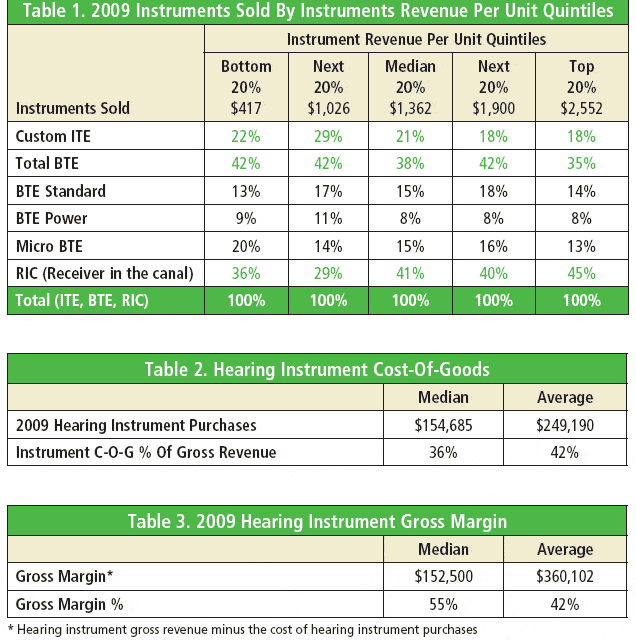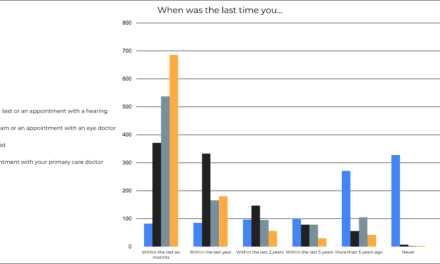Part 2: Profits, Compensation, Marketing, and Hearing Testing
This is Part 2 of a two-part benchmarking survey designed to provide US hearing care practices with a tool they can use to compare their performance against industry standards. These industry benchmarks can be used as a basis for assessing and setting realistic, continuous, and fact-based improvement goals for your own dispensing office or practice.
For the past 3 years, Phonak Hearing Systems has commissioned Customer Care Measurement and Consulting, LLC, Alexandria, Va, to conduct a nationwide survey of dispensing professionals to establish basic industry metrics. A Web-based survey methodology was utilized. Responses were collected in July 2010, and more than 400 hearing care professionals responded. About two-thirds (63%) of respondents were audiologists (38% AuD, 19% MS, and 6% PhD), and 44% were either hearing instrument specialists (38%) or audioprosthologists (6%). (Totals do not equal 100% due to multiple answers.) One-fifth (20%) of the practices indicated having both audiologists and hearing instrument specialists on staff.
This article was submitted by the Phonak market research department and adapted from the company’s publication Key Metrics of Hearing Practices: 2010 National Research Study, which reports on the independent survey results conducted by Customer Care Measurement & Consulting, Alexandria, Va. Correspondence can be addressed to HR or Phonak Senior Manager of Marketing Kimberly Rawn at .
Part 1 of this article,1 published in the June edition of The Hearing Review, looked at some of the most important measures of a hearing care business, including gross revenues, staffing, and revenue per staff member. Part 2 looks at several other key measures, including hearing aid styles and fitting fees, professional compensation issues, marketing, new patient sources, testing, and fitting/service procedures.
Hearing Aids, COGs, and Profits
Styles and RICs. As discussed in Part 1, hearing practices reported that an average of 21% of instruments dispensed during 2009 were ITEs, 40% BTEs, and 38% RICs. Practices in the top 20% of instrument revenue per unit dispensed quintile sold a higher proportion of RIC units (Table 1).
COGs. In terms of cost-of-goods (COGs), hearing instrument purchases accounted for 36% of practice gross revenue in the median practice (Table 2). This ratio is calculated by dividing the total amount spent for hearing instruments by the total practice gross revenue for a specified period.
Gross margin. Gross margin percentage is calculated by subtracting the wholesale cost of instruments from the gross revenue from hearing aid fitting fees to derive the gross profit, then dividing the resulting gross profit by gross fitting revenue. The median hearing practice earned gross profits from fitting instruments of $152,500 during 2009 (Table 3). The median gross profit margin percentage for fitting hearing instruments is 55%, representing a mark-up of 2.1 times wholesale cost for the median product and fitting fee.
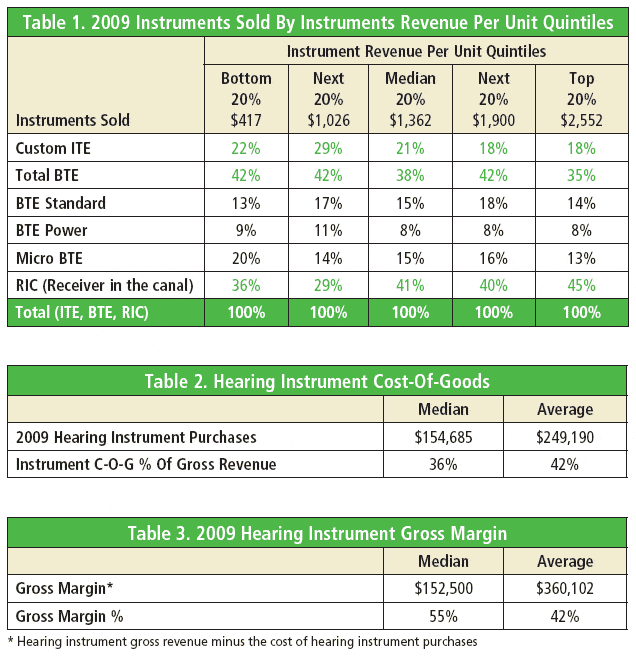
Returns. The survey results suggest that an average of 13% of hearing aids purchased are returned for credit (6.5%) or exchanged (6.4%) in all practices, which is considerably lower than return-for-credit statistics (nearly 19% overall in 2011) reported by industry manufacturers—a consistent finding with most dispenser surveys.2,3
Professional Compensation
When excluding the practice owners, 61% of hearing practices employ licensed hearing care professionals. Not surprisingly, solo professional and smaller practices are much less likely to employ hearing professionals (in addition to the practice owner) than practices with multiple professionals/locations and larger practices. Of practices that employ licensed hearing professionals (in addition to the practice owner), 41% compensate employed professionals with salaries and commissions, 32% pay salary only, and 17% pay salary plus bonus, while only 10% base pay on commissions. Two-thirds of all practices provide health insurance to employed professionals.
Table 4 shows that median compensation received by practice owners in 2009 was $87,500 (including benefits), with an average of $110,023. For solo professional single-location practices, the owner’s total compensation amounted to a median of 25% of total gross revenues, and a median of 17% for single-office practices owned by two or more professionals. In multi-location practices, the owner’s compensation was a median of 12% of gross revenues.
Both business managers and employed professionals received median compensation of $62,500 (Tables 5 and 6). Business managers were reported to average $83,625 in compensation, while professional employees were reported to average $76,014.
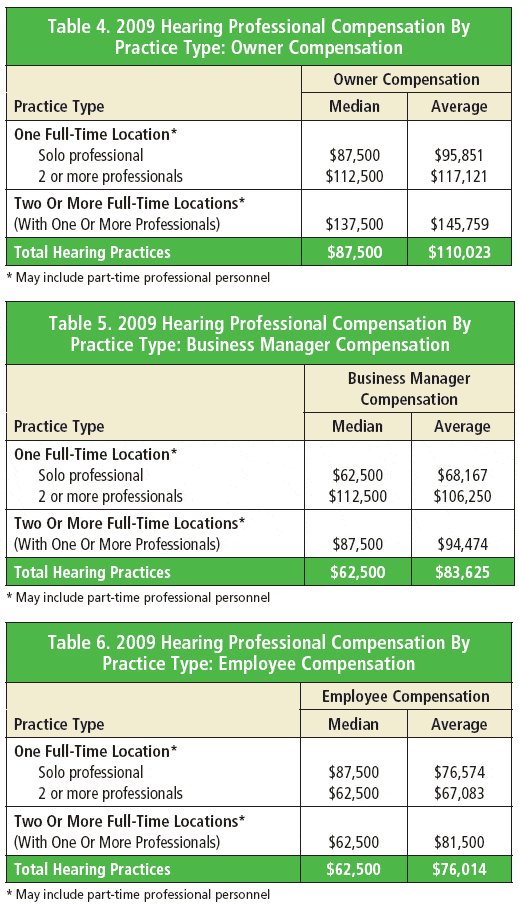
Practice Marketing
Marketing expenditures. The median hearing practice spends 4.8% of gross revenue for marketing, or $15,000 annually (Table 7). More aggressive marketers (top 20% of practices on basis of marketing spending ratio) spend 17.6% of gross revenue on marketing (Table 8). Not surprisingly, multi-full-time-location practices spent the most on marketing during 2009 (Table 9), with a median of $75,000 spent on marketing, and an average of 8.8% of their gross revenues. In contrast, single-location practices invested a median of $10,000 to $24,500 for their marketing, or an average of 5.9% to 6.6% of their gross revenues. The percentage of gross revenues that a practice spends on marketing can be affected by a number of variables, including the level of physician referrals, the practice setting, and the particular goals of the practice.
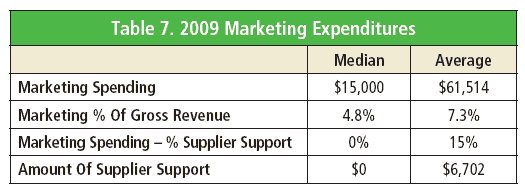
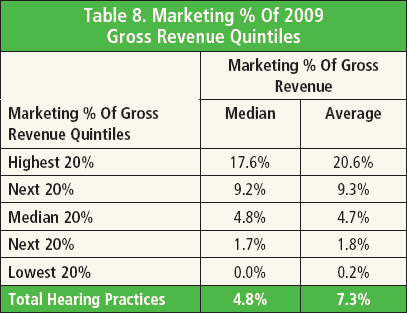
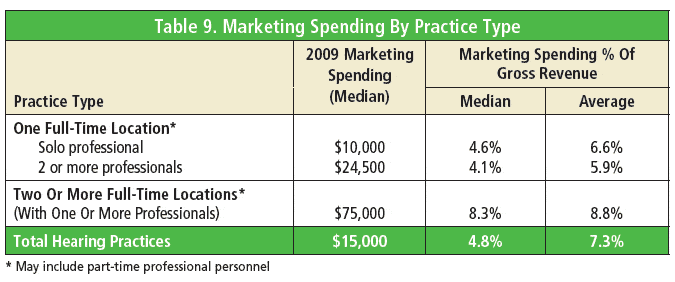
Marketing plans. A total of 41% of practices report that they develop a marketing budget before the start of each year and 44% develop a marketing calendar (Table 10). For the two smallest quintiles relative to gross revenue, less than one-third create a marketing budget or a marketing calendar. Although over half of practices apparently make ad hoc decisions about marketing tactics during the year, it is apparent that the largest practices are more likely to develop marketing plans.
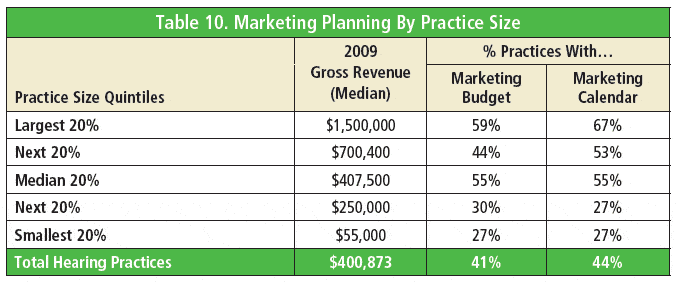
Marketing vehicles. The most commonly used forms of marketing include newspaper advertising and direct mail (Table 11). Among practices using newspaper advertising (ie, excluding practices that did not use newspaper advertising), the average amount of the budget spent on newspapers was 39%, while practices which used direct mail (ie, excluding practices which did not use direct mail) spent an average of 34% of their marketing budget on this activity. A total of 45% of practices spent some of their marketing budget on Web site development, and 30% of practices published a newsletter. Significant but smaller percentages of practices used open houses (29%), seminars (22%), or broadcast advertising (17% TV and 15% radio) to attract new patients. Usage of marketing tactics does vary somewhat by practice type and practice size. Multi-full-time-location and larger practices are more likely to use direct mailer programs and newspaper ads than single full-time-location and smaller practices.
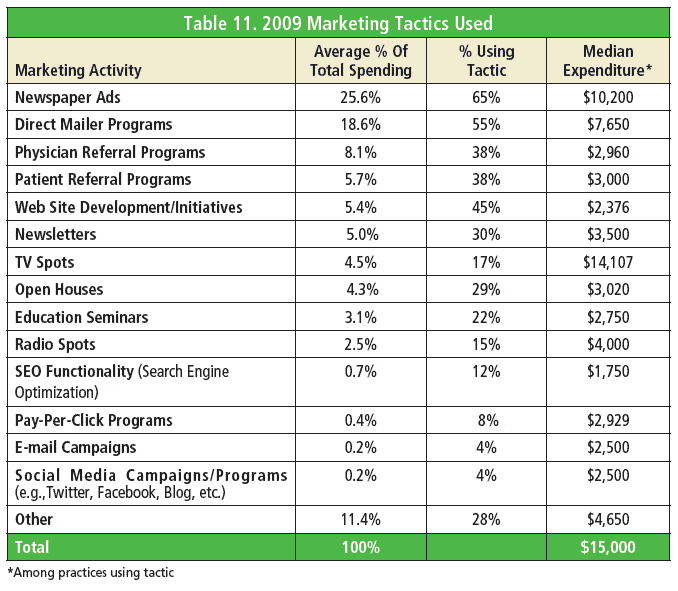
A majority of hearing practices (57%) rated their 2009 marketing program as only somewhat effective, indicating an opportunity for many practices to improve their marketing efforts. Practices spending the lowest ratio of gross revenue for marketing rated the effectiveness of their programs lower than other practices.
Marketing tactics receiving the highest effectiveness ratings included patient referral programs, physician referral programs, open houses, education seminars, newsletters, and direct mail (Table 12). Although relatively few practices judged any of these top-6 tactics as “very effective,” the vast majority (?75%) reported that they were at least “somewhat effective” or “very effective.”
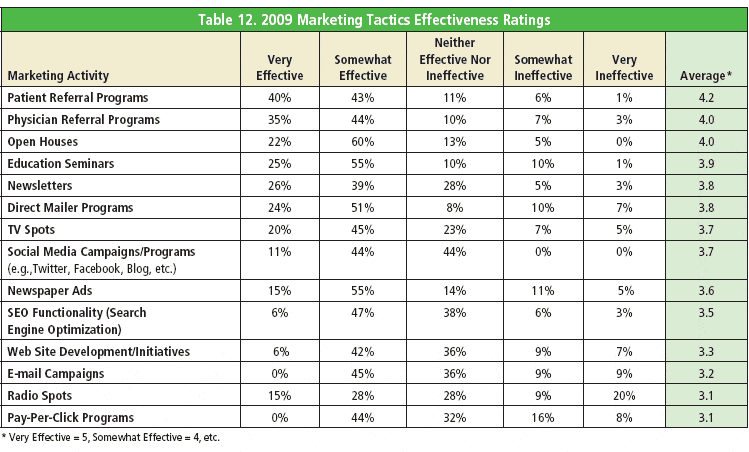
Practice Web sites. Three-quarters (76%) of practices have a business Web site, including 76% of single full-time-location/solo professional practices. Larger practices are more likely to have a Web site than smaller ones. While just over half of the smallest practices have Web sites, 88% of the largest practices have Web sites. Nearly three-fourths of practice Web sites included hearing information archive functionality, and nearly two-thirds of practice Web sites have a section to accept patient inquiries. Only 1 in 5 sites enabled appointment scheduling by patients. Just under half use search engine optimization (SEO).
Sources of new patients. Referrals are the major source of new patients for hearing practices, accounting for an average of 46% of new patients (Figure 1). Referrals from physicians produced an average of 25% of new patients; referrals from current patients produced an average of 21% of new patients.
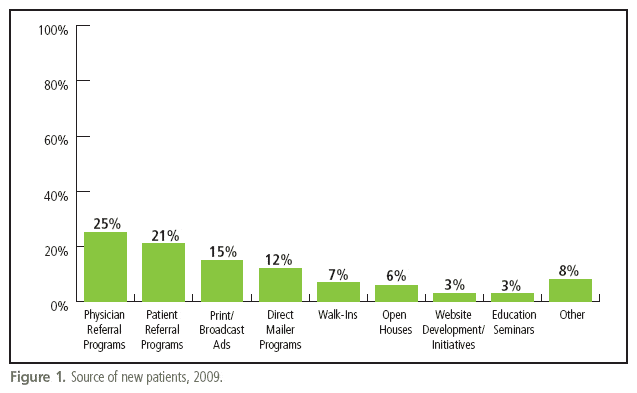
When considering only physician referrals, primary care physicians accounted for an average of 43% of these referrals, ENT specialists accounted for an average of 30%, while nursing homes (8%), senior center counselors (4%), and hospitals (2%) rounded out the physician referral list.
The bottom line: The Practice Performance Comparisons worksheet (PDF), shows the percentage of practice gross revenue invested in marketing during 2009 based on the responses to this survey. The metric is calculated by dividing total 2009 marketing spending by 2009 practice gross revenue. You can perform this calculation yourself. If your marketing spend is below 4.8% of gross revenue, or the percentage of new patients generated from referrals is greater than 50%, your practice is probably underinvesting in marketing.
Patient Testing and Recall
A median of 50% of patients receive a hearing aid demonstration as part of routine counseling services. Speech-in-noise tests, real-ear measures, and the Client Oriented Scale of Self Improvement (COSI) are used most often by practices for the routine fitting and verification of hearing aids (Figure 2). In 36% of practices, 75% or more of the patients receive initial instrument fittings that include real-ear or live-speech mapping. However, 29% of the practices do not offer their patients real-ear or live-speech mapping services at all, and only one-fifth (20%) of practices offer it for all their patients.
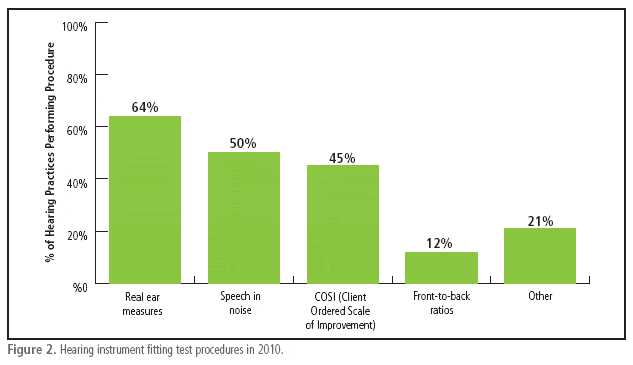
About one-third (37%) of practices regularly conduct patient satisfaction surveys. Most of those practices conducting surveys (82%) share the results with their staff members.
Most hearing practices (81%) schedule recalls for cleaning. These practices schedule quarterly cleaning for an average of 32% of their patients and schedule cleaning on a semi-annual basis for 39% of their patients. About three-fourths (77%) of hearing practices schedule recalls for hearing tests, with annual hearing tests for an average of 72% of patients. There is no consistent relationship between the gross revenue per professional hour of a practice and the recommended intervals between patient visits or the types of fitting tests performed.
Professional Training
About 4 in 5 (79%) hearing practices had professionals who attended a business or patient management education program in 2009. The most common topics covered in these programs were product fitting, marketing management, technical patient counseling, and service quality. Hearing practices received a median of 40 hours of training across the practice during 2009, and an average of 90 hours. An average of half of the training hours were spent on product fitting.
Benchmarking Your Practice’s Business Metrics
How do you measure your business success? By the number of units dispensed? By the comparison of this year’s sales to last year’s sales? By your profit margin? If you answered “yes” to any of these questions, you are like thousands of other small business owners who turn to their accountants and their balance sheets for measurement of business achievements and failures.
Although bottom-line results are important and provide critical insight into the financial health of your business, such statements only report end results. They offer no insight into why the numbers are as they are. It is only by combining financial and nonfinancial measures that you can get a true picture of business performance.
The downloadable worksheet called Practice Performance Comparisons (PDF) lists all the metrics discussed in Parts 1 and 2, as well as other important business indicators. This worksheet is designed to provide you with an opportunity to print out and fill in your own business metrics, then compare them directly with the metrics of similar practice types and sizes.
During the past 3 years in which Phonak has measured business metrics and shared the results with dispensing professionals, we’ve learned more about how these metrics can be used by practice owners and managers. Some of this can be as simple as reassurance that the practice is on the correct course. For example, Christopher Hamilton, AuD, of The Hearing Center of Asheville, NC, says, “Benchmarking data has provided an invaluable perspective on real numbers related to private practice and running a business. In the relatively insular world of business ownership, there is nothing quite like being able to see exactly where you stand relative to other businesses. The wide range of topics and specific data points allows for a broad scope of comparison and provides a platform for strategic business planning.”
Others use the metrics in a more granular way. For example, Paul Depp, AuD, of Audio Recovery, Oklahoma City, says, “We use gross revenue per square foot to determine whether our clinic should acquire more space for our practice. We also use productivity ratios as a good ‘thermometer’ for us to see if a clinician performs well compared to the benchmark. It helps us to evaluate whether we need more training, such as reducing return for credit, improving closer rate, etc.”
Similarly, Jennifer Black, MA, of Carle Audiology and Hearing Services, Champaign-Urbana, Ill, says, “We used the benchmarking survey to prove to administration that other practices actually advertise and compared our advertising budget versus the median and average spent on advertising. This led to the approval and development of our hearing and audiology website, which is separate from the physician’s website.”
Benchmarking your practice can also help you understand where the practice should move in the future and provide some solid numbers to your goal-setting and objectives. Mary Mungovan, AuD, Director of Audiology at Whisper Hearing Centers/Otolaryngology Associates, Carmel, Ind, says, “The benchmarking survey has been helpful when setting sales forecast goals. I found it particularly useful when we were doing research on expansion and wanted to extrapolate performance characteristics to sites built on a different business model than our current ENT/Audiologist sites.”
References
- Phonak Market Research. A survey of key metrics for benchmarking a hearing practice. Hearing Review. 2011;18(6):24-34.
- Hearing Industries Association. Statistical reporting program: 4th quarter 2010. Washington, DC: HIA; 2011.
- Strom KE. The HR 2006 dispenser survey. Hearing Review. 2006;13(6):16-39.
Citation for this article:
A Survey of Key Metrics for Benchmarking a Hearing Practice, Part 2 (compiled by Phonak) Hearing Review. 2011;18(7):24-30.

